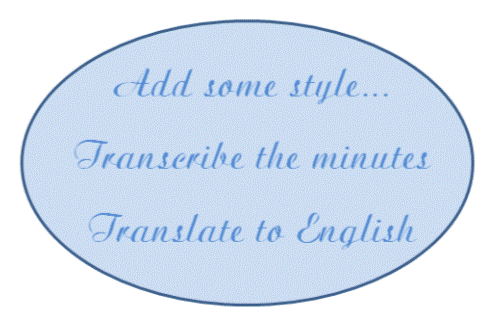I hope you find my writing and business tips and observations useful. My business and blog are dedicated to helping businesses communicate clearly and reach their potential.
Read, subscribe to my newsletter, enjoy!Tash
Translation and transcription styles
As a writer and communications manager, style guides are important.
It was only when I read a book by a freelance translator and transcriber, Kris Emery, that I thought about style guides for other professionals dealing with words.
Getting written documents
If your business need documents translated or meetings transcribed, you are paying someone to give you a written document that will be used in some way.
So obviously you want that document to be prepared in a way that is easy for you to use.
That could include details such as :
- being in your prefered font size so it’s easy for you to read and manage
- spelling certain words in a particular way – it could be ebook vs eBook or it could be how you want your business or product name represented (think of AvSuper, McDonalds and WordPress for instance)
- putting meeting records into columns to separate names from conversations
- location of your logo – you could add it yourself, but why not get the document ready for use?
- having page numbers or preparation dates in a certain place on each page
- things to exclude from a transcription (eg remove um, ah and y’know but leave uhuh)
- page margins or text justification that suits your needs, such as fitting onto a letterhead or space for notes around the text
Preparing a style guide
You have a number of options really…
- rely on the person just to translate/transcribe and change the style yourself
- assume the person will give you a nice format without guidance and just fix the rest – or get lucky and find someone who will ask the questions to give what you want (and probably write a style guide themselves to use when they next work with you – expect to pay for it if you want access to that style guide yourself)
- provide a template and hope the person doesn’t adjust it or any coding behind it
- provide a style guide (or at least a style sheet if your requirements are few) for them to work from
A document-specific style guide will by nature be about details, lots of little details that add up to a polished and useful end result.
It can be pulled together in two hours or so if you have an existing document to work from; faster if you have a style template to work from. That’s not much time compared to adjusting a document every time someone translates or transcribes for you.
What are the first three things you would add to your style guide?
Are they things you consider the most important or just the hardest to do so you prefer someone else gets them right?
Updated corporate style guide
I have just read a memo from a client’s supplier about an update to their corporate style guide.
The article explains the value of the style guide, with comments such as “maintaining a consistent look and feel to all materials was crucial in maintaining a positive and lasting impression of the organisation.”
Comprehensive style guide
As is often the case, the article discusses the design elements of the brand (such as where the logo goes on letterheads, forms and advertising). Designers often prepare (or advice on) a style guide that is actually a design style guide; a comprehensive corporate style guide will include all elements of the brand style such as spelling and punctuation conventions and writing style.
They also make the mistake of using the word brand instead of logo – brand is so much more than a logo.
For true consistency, a style guide must include everything. It can then be split into components for specific uses – such as pulling out the website design section for a web designer or the logo and colours for a form designer.
Logo guidelines
In case you are working on your style guide, here are some of the key points this article mention about use of their logo to get you thinking more broadly.
- only use the logo in provided formats and colours
- use the logo only once in corporate documents
- use the entire logo (i.e. don’t split the image from the text)
- never print other images or word over the logo
- logo must be prominent
- unless using a provided template, get approval from {name} before using logo in external materials
Have you considered all those issues for your logo and included them in a style guide?
Are templates cheating?
Sometimes people talk about templates as if they are cheating, inferior and inappropriate as a business tool.
I don’t agree – there are times a template is not the right answer but they can be very useful in business.
Using a template doesn’t mean everything is exactly the same – adjustments are made to suit the purpose.
Templates for letters, emails, style guides, procedures, web pages and other business materials can help your business in three key ways.
- Consistency
If every letter sent from your business has the same format, it looks professional, builds your brand and shows attention to detail - Time saving
Using a template saves a lot of time. An email or webpage template can reduce the time needed for formatting, setting meta data and remembering the necessary details (phone, ABN, disclaimer, etc), and so on. - Getting started
A template can provide a starting point and can be much easier to work from than a blank page – this saves mental energy and time. If you don’t know where to start with preparing a style for your business, a corporate style guide template can get you started and inspire you to ask the right questions
I think templates are suitable for many things (e.g. procedures and standard information) although they can be misused and abused.
What templates do you use (or have you used) in your business? What advantages do you get from them?
Branding the little things
Building a brand is an important way to develop your business and attract customers, but I read a blog post recently that reminded me of branding even the small things to match your style guide.
Kylie posted that customising and branding your invoices is useful, and quite easy. Personally, I have always had my logo and other details in my invoices, but I hadn’t thought about changing the font. Many people would say that invoices are boring and nuisances rather than marketing tools – and that no one would ever notice what font the dollars are printed in – but it still part of being consistent and reinforcing the look of your business. It also shows an attention to detail for anyone who does notice the details of your invoice.
So, is your invoice branded? Does that include choice of font, wording style and colours/backgrounds?



Recent Comments